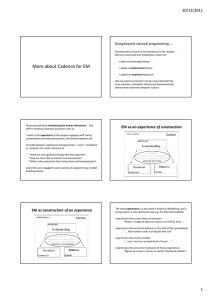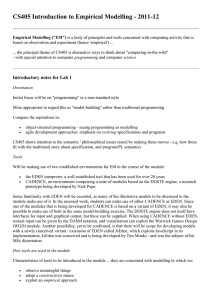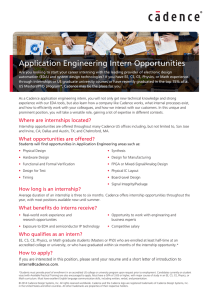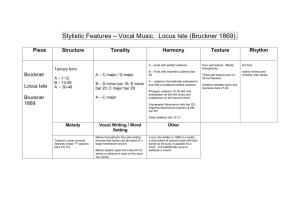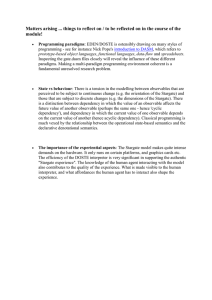10/11/2010 EM as construction of an experience Going beyond classical programming ….
advertisement
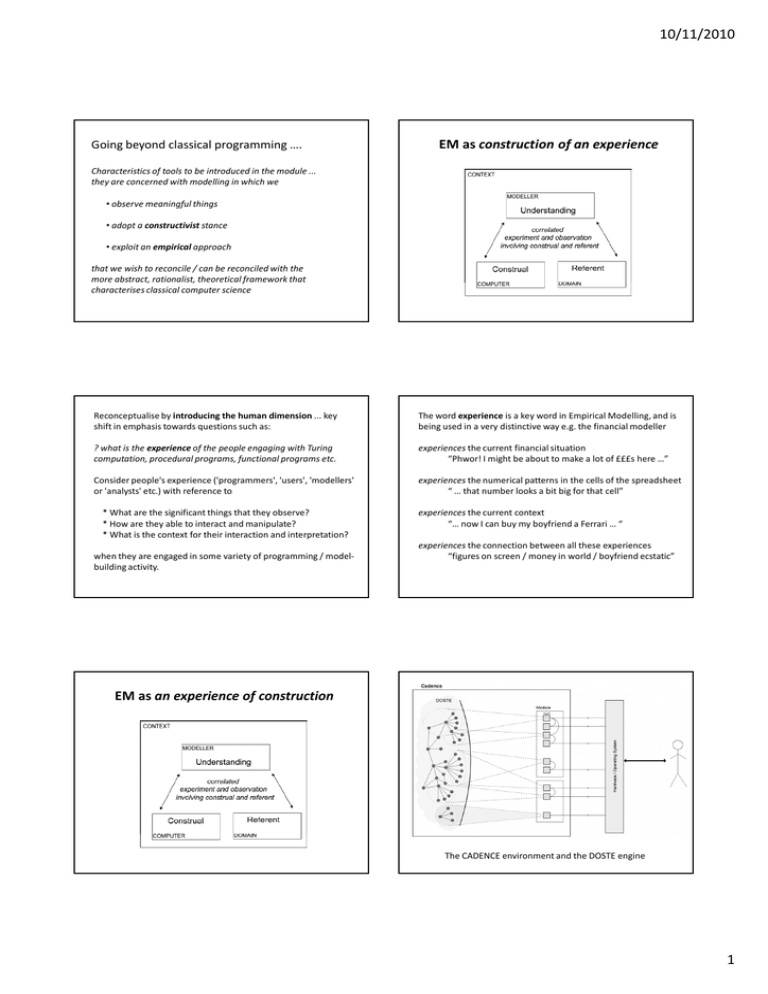
10/11/2010
Going beyond classical programming ….
EM as construction of an experience
Characteristics of tools to be introduced in the module ...
they are concerned with modelling in which we
• observe meaningful things
• adopt a constructivist stance
• exploit an empirical approach
that we wish to reconcile / can be reconciled with the
more abstract, rationalist, theoretical framework that
characterises classical computer science
Reconceptualise by introducing the human dimension ... key
shift in emphasis towards questions such as:
The word experience is a key word in Empirical Modelling, and is
being used in a very distinctive way e.g. the financial modeller
? what is the experience of the people engaging with Turing
computation, procedural programs, functional programs etc.
experiences the current financial situation
“Phwor! I might be about to make a lot of £££s here …”
Consider people's experience ('programmers', 'users', 'modellers'
or 'analysts' etc.) with reference to
experiences the numerical patterns in the cells of the spreadsheet
“ … that number looks a bit big for that cell”
* What are the significant things that they observe?
* How are they able to interact and manipulate?
* What is the context for their interaction and interpretation?
when they are engaged in some variety of programming / modelbuilding activity.
experiences the current context
“… now I can buy my boyfriend a Ferrari … “
experiences the connection between all these experiences
“figures on screen / money in world / boyfriend ecstatic”
EM as an experience of construction
The CADENCE environment and the DOSTE engine
1
10/11/2010
Terminology for describing a DOSTE structure
a) Node
b) Edge (directed and labelled)
c) Context, or in cases where there is a
more concrete interpretation it may
be called an object.
d) Value
e) Property (or quality)
f) Observable (requires a context and
property). If the context is interpreted
as an object then this may be called
an attribute.
Aspects of Stargate featured in the Cadence model
components - chevrons / symbols
attributes – where chevron is, whether lit up
behaviours – process-like observables that are changing
visual characteristics – geometry and textures
states of the Stargate – with or without the puddle
viewpoint perspective – e.g. from moving spaceship?
with smoke in the cabin?
• orientation of the Stargate
• status of human agent – Cadence model-builder vs gamer
• context for the human agency
• is the Stargate in motion?
• are we trying to correct a flaw in the visualisation?
• are we assessing the model aesthetically or technically?
•
•
•
•
•
•
All state and every kind of manipulation of state in the
Stargate model is expressed by framing definitions
Contrast with traditional software development, where
requirements, design, implementation, testing distinct …
In Cadence, all these activities can be supported within
one and the same environment …
The guiding principle for the development is at all times
matching what is as-of-now observed in the referent to
what is as-of-now embodied in the construal
This gives uniformity and consistency to the experience
of the modeller quite unlike traditional programming as
classically conceived …
Empirical Modelling as Construction
Cadence has
exceptional
qualities in
respect of
management of
observational
contexts and the
development of
construals on a
computer
Many interpretations of construal …
Compare and contrast …
- assigning a value to an observable (=)
- establishing a dependency relation (is)
- introducing a process-like observable (:=)
These account for meaningful interaction in whatever
observational context, whether directly experienced by
a human agent or projected on to an automated agent
Contrast with traditional software development, where
requirements, design, implementation, testing distinct
- making sense of Stargate
- creating a radically new software system
- making a financial spreadsheet
- devising a walk
- discovering electromagnetism
All involve engaging with the world and making
some form of construal of a referent
2
10/11/2010
Specialising the context for construal …
Simplifying assumptions, such as in spreadsheets:
- context not too rich (cf. sheets in ss)
- autonomous behaviour is limited
(cf. ss doesn’t change by itself)
- perceived structure is primitive / embryonic
(cf. Faraday’s experimental world)
- modeller not an expert in software development
(cf. ss interfaces for input / visualisation)
- modeller has domain-specific expertise
(cf. ss functions average/sum and pie charts)
… basis for older EM tools more limited than Cadence
Stargate in Cadence
The EDEN tool …
Simplifying assumptions, such as in spreadsheets:
- context not too rich (» use scripts of definitions)
- autonomous behaviour is limited
(» only use ‘is’ and ‘=’ definitions)
- perceived structure is primitive / embryonic
(» have a flat space of observables)
- modeller not an expert in software development
(» modeller frames defns / programs functions)
- modeller has domain-specific expertise
(» supply familiar types, operators, depictions)
… basis for older EM tools more limited than Cadence
Several motivations for studying EDEN …
Cadence is still a research prototype in development
Cadence is exceptionally powerful and expressive, but
there is a ‘science’ to using it for Empirical Modelling:
cf. the ‘scientific method’, good engineering design
Stargate in the ‘definitive notation for line drawing’ DoNaLD in EDEN
Extracts from the cartoonstargate script
%donald
point centre
int outrad, midrad, innrad
circle innc, midc, outc
point inn1, …, inn39
point out1, … , out39
line spoke1, …, spoke39
spoke1 = [inn1, out1]
centre = {500,500}
innc = circle(centre, innrad)
midc = circle(centre, midrad)
outc = circle(centre, outrad)
innrad = 200
midrad = 300
outrad = 400
inn2 = centre + {innrad @ theta2}
out2 = centre + {midrad @ theta2}
theta2 = theta1 + (2 - 1) * 2 * pi div 39
Experience with EDEN clarifies the principles underlying
the use of Cadence for EM, and informs the design of
interfaces for the use of Cadence by non-programmers
point chev9L, che9R, chev9V
line chev9LV, chev9RV
chev9LV = [chev9L, chev9V]
chev9RV = [chev9R, chev9V]
Many EDEN projects developed over twenty years:
chev9L = centre + {outrad @ ((pi + chevsubtend) div 2 - (2-1)*chevangle)}
chev9R = centre + {outrad @ ((pi - chevsubtend) div 2 - (2-1)*chevangle)}
chev9V = centre + {radchev9V @ (pi div 2 - (2-1)*chevangle)}
radchev9V = if (locked9) then midrad else (midrad+outrad) div 2
http://empublic.dcs.warwick.ac.uk/projects/
real chevsubtend
chevsubtend = 0.1
real chevangle
chevangle = 8 * pi div 39
boolean locked9
int radchev9V
locked9 = false
3
